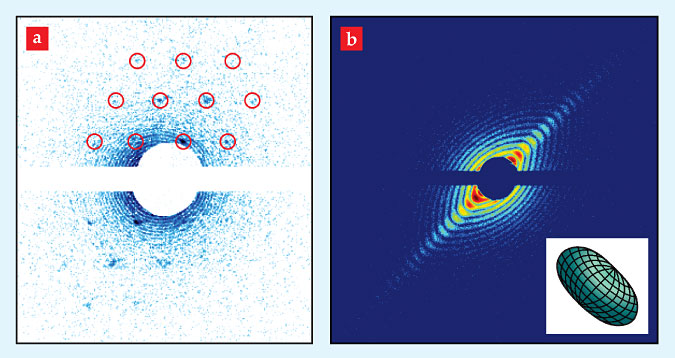Quantized vortices in a nanodroplet
DOI: 10.1063/PT.3.2571
Spin a vessel of water and, in time, the fluid will rotate as a rigid body, everywhere circling with the same angular velocity. Replace the water with a superfluid—a liquid chilled to a viscosity-free quantum state—and the flow instead spawns quantum tornadoes, vortices in which fluid circulates with quantized angular momentum.
First predicted more than a half century ago, quantized vortices have been studied extensively in experiments with rotating cryostats of liquid helium. They are thought to underlie such exotic phenomena as quantum turbulence (see the article by Joe Vinen and Russell Donnelly, Physics Today, April 2007, page 43
When it comes to elucidating the underlying physics of rotating superfluids, however, cryostats have their limitations. Defects along the container’s surface inevitably disturb the flow in ways that can’t be neatly captured by theory. Plus, bulky cryostats can be spun only so fast, typically no more than a few rotations per second. Many interesting phenomena are thought to emerge at higher angular velocities. Now an international collaboration led by Christoph Bostedt (SLAC), Oliver Gessner (Lawrence Berkeley National Laboratory), and Andrey Vilesov (University of Southern California) reports the detection of quantized vortices in fast-spinning, container-free ver-sions of rotating vessels: liquid-helium nanodroplets. 1
Vilesov first began working with droplets two decades ago, as a postdoc in J. Peter Toennies’s lab at the Max Planck Institute for Dynamics and Self-Organization in Göttingen, Germany. There the researchers figured out that if they cooled helium-4 to about 15 K and sprayed it into a vacuum, they could make a beam of helium nanodroplets. Friction with the nozzle sets the droplets spinning at up to millions of rotations per second, and evaporative cooling chills them to a superfluid state. (See the article by Toennies, Vilesov, and Birgitta Whaley, Physics Today, February 2001, page 31
The team verified the droplets’ superfluidity—at least at molecular length scales—by seeding them with sulfur hexafluoride: The immersed molecules exhibited sharp rotational peaks in their IR spectra; in a normal fluid, those modes would have been damped by viscous forces. 2 Less obvious was how one might image the quantized vortices—if they even existed. Some theories held that the vortices would be unstable or energetically unfavorable in such tiny droplets.
Portrait of a superfluid
Encouraged by recent developments in ultrafast imaging with free-electron lasers, Bostedt, Gessner, and Vilesov hatched a plan to look for the vortices using x-ray diffraction. The idea was to dope the droplets with xenon atoms, which tend to cluster along the vortex cores and provide x-ray scattering contrast. Assuming the vortices settle into ordered arrays, as they do in rotating cryostats, they might show up in diffraction patterns as Bragg peaks.
The researchers secured a week of beam time at SLAC’s Linac Coherent Light Source, where they imaged thousands of droplets, one at a time, by spraying them through the pulsed laser’s focal volume. Panel a in the figure shows an image taken head-on along a droplet’s spin axis. The triangular lattice of Bragg peaks is indicative of a triangular array of vortices, their cores aligned with the droplet’s spin axis. From the spacing between peaks, the researchers estimate that the droplet, 2 µm in diameter, contained roughly 160 vortices and was spinning about 350 000 times a second.

X-ray diffraction images hint at the flow structure and shape of micron-sized superfluid droplets. (a) A triangular lattice of Bragg peaks, circled in red, reveals an ordered array of quantized vortices in one droplet. (b) In an image of a different droplet, oblong interference fringes indicate that the droplet has bulged at its equator and flattened at its poles, as sketched in the inset. (Adapted from ref.

Panel b shows another droplet, just 800 nm in diameter, imaged from the side. The oblong fringes result from diffraction by the helium droplet itself: The more widely spaced fringes in the northeast–southwest direction indicate that the droplet is narrower in that direction; the narrowly spaced fringes in the northwest–southeast direction indicate the droplet is wider. By inverse Fourier transform, the team obtained the sketch shown in the inset. As expected, the spinning droplet bulges at its equator, but the extent of the deformation is surprising: Twice as wide as it is tall, the droplet has bulged so severely as to flatten at its poles. From that shape profile, the researchers estimate that the droplet was rotating more than 2 million times per second. At equivalent angular velocities, a classical droplet would have begun to pull apart to form a two-lobed, peanut-like structure, with the spin axis piercing the peanut’s waist. 3
Curiously, fast-spinning droplets like the one imaged in panel b don’t display Bragg peaks. The researchers suspect that could be a sign of new physics—perhaps a transition to a disordered or nonstationary phase or the onset of an unidentified hydrodynamic instability. The answer may be buried somewhere in the data. “So far we’ve analyzed less than 5 percent of our images—the ones that show the most intense, well-defined Bragg spots,” says Vilesov. “But many of the other images show more complex diffraction patterns, and presumably those will also tell us something about the vortex arrangements. Hopefully, there are more surprises to come.”
References
1. L. F. Gomez et al., Science 345, 906 (2014). https://doi.org/10.1126/science.1252395
2. M. Hartmann et al., Phys. Rev. Lett. 75, 1566 (1995). https://doi.org/10.1103/PhysRevLett.75.1566
3. R. J. A. Hill, L. Eaves, Phys. Rev. Lett. 101, 234501 (2008).https://doi.org/10.1103/PhysRevLett.101.234501
